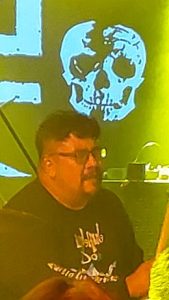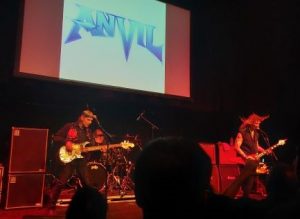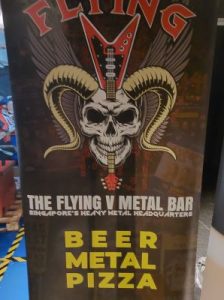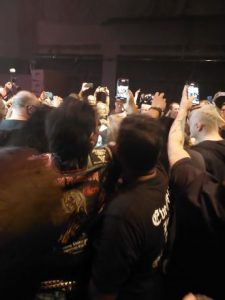
When I was a teenager in the United Kingdom, I recall people of my parents’ generation rolling their eyes in disgust when the radio or TV played music made by and aimed at young people. They regarded the musicians as ‘uncouth’ and ‘disrespectful’ – the Sex Pistols, for example, fronted by a young Johnny Rotten, sneering their way through God Save the Queen, or Motörhead, fronted by a young Lemmy, growling their way through Ace of Spades – and the music itself as ‘just a racket’. There was, these members of the older generation agreed, only one way to cure the malaise of delinquency and degeneracy that’d afflicted younger folk and turned them into noisy spiky-haired louts and noisy long-haired hooligans…
“National service!” they’d agree. “Bring back national service! That’d teach these young whippersnappers some manners! That’d sort them out!”
Well, the existence of the Singaporean band Wormrot nullifies that argument. They are evidence that national service may not be the antidote some think it is for curing society’s younger members of their urge to make loud, unruly and unholy music. For the band formed in the late 2000s immediately after its founding members, vocalist Arif Suhaimi, guitarist Rasyid Juraimi and drummer Fitri completed the two years of national service that Singapore requires of its young male citizens. Having hung up their uniforms and become Wormrot, the trio dedicated themselves to the noisy subgenre of grindcore, which Juraimi once described in an interview as “a bastard child of punk and metal with less limitation.”
Wormrot have achieved some notable things. They were the first Singaporean act to play at Britain’s Glastonbury Festival, in 2017, though they had to perform in unusually cramped conditions – their stage was inside a train carriage, with its seats removed, which’d been dubbed the ‘Earache Express’. And they’ve supported the legendary Napalm Death. Even people who’ve never listened to grindcore, and have no idea what it is, know the name ‘Naplam Death’.
And fabulously, it was at one of their French concerts in 2012 that pictures of ‘Biquette the Grindcore Goat’ first went viral. Biquette was, yes, a goat. She was rescued from a milking factory and adopted by a communal farm, and she famously enjoyed being at the front of the crowd at heavy metal and punk concerts.
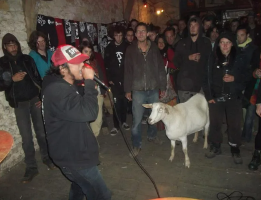
From disciplinemag.com
Yet things looked slightly bleak for Wormrot in recent years. Fitri departed from the band in 2015, with Vijesh Ghariwala taking over the drumkit for the next nine years. However, the band was less able to absorb the blow of losing vocalist Suhaimi in 2022. They had to embark on a world tour using Gabriel Dubko (of the German band Implore) as a temporary, stand-in singer. As a result, they arrived back in Singapore lacking the services of a full-time vocalist.
Happily, both Suhaimi and Fitri rejoined Wormrot in 2024, meaning the band has now reverted to its original line-up. The middle of this month saw them appear at an event with the self-explanatory title SG Metal Mayhem V, held at the Singaporean venue Phil Studio. Though Wormrot were the third of four bands on the bill, and thus weren’t the headliners, I suspect it was their presence that attracted the bulk of the local crowd – this was a chance to see the rejuvenated band back in business.
I couldn’t leave work until after SG Metal Mayhem V had started and unfortunately I missed the opening act, Microchip Terror, an artist who specialises in ‘electronic body horror music’. I’ve listened to some of his stuff online and, to me, it seems an intriguing blend of Nine Inch Nails, synthy old John-Carpenter movie scores and death metal vocals. I made it there in time to catch the second band, the Japanese outfit Kruelty who, their website claims, “find that sweet spot… of heavy beatdown hardcore and 90s American / Scandinavian death / doom metal…” Kruelty’s vocalist Zuma (Kohei Azuma) was in fine growly form and their set was well-received.

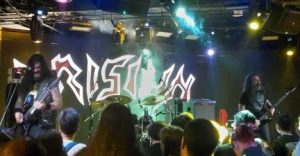
Also growly and well-received were the evening’s headliners, the veteran – on the go since 1990 – Brazilian death metal band Krisiun. This outfit’s line-up consists of three brothers: vocalist and bassist Alex Camargo, guitarist Moyses Kolesne and drummer Max Kolesne. When I think of bands containing three or more siblings, the Bee Gees, the Osmonds, the Jackson 5, Hanson and the Corrs spring to mind, but Krisiun are a wee bit less… genteel than that lot. With their beards, long hair, denims and tattoos, they have an outlaw-ish / biker-ish vibe. If Lemmy had ever played a warlord in a post-apocalyptic sci-fi movie – he was in one such movie once, but in a minor role – I could imagine this trio playing his phalanx of bodyguards. Anyway, Krisiun delivered the goods at SG Metal Mayhem V, their aggressive vocals and brutal sound offset by some impressively virtuoso guitar-playing.
But before that, the crowd got to see – and certainly got to hear – local heroes Wormrot. The cacophony they produced, and its pleasures, are best summed up by a comment about them I read on Reddit. After attending a Wormrot gig, the writer “couldn’t hear the whole way home” and a ringing in his ears “didn’t go away for a couple days,” but… “It was fantastic.” Yes, by standing within earshot of Juraimi’s manic guitarwork, and Fitri’s frenzied drumming, and Suhaimi’s inhuman screeching, you’re subjecting yourself to a massive sonic assault. But the experience is strangely wonderful.
The delighted crowd showed their appreciation by forming a mosh-pit – though this being Singapore, it was a slightly less bone-juddering mosh-pit than in other metal gigs in other parts of the world. It more resembled a demented conga-line. There were also attempts at crowd-surfing, though these threatened to end up like Jack Black’s famously disastrous attempt to crowd-surf in School of Rock (2003).
And sweetly, I think I saw someone wearing a T-shirt emblazoned with the words Grindcore Goat. Rest in Peace, Biquette.


